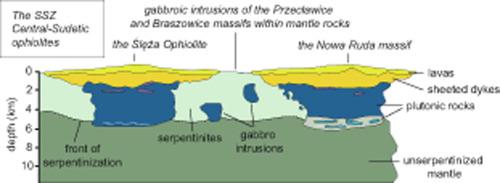Gondwana Research ( IF 7.2 ) Pub Date : 2021-10-05 , DOI: 10.1016/j.gr.2021.09.015 Piotr Marian Wojtulek 1 , Bernhard Schulz 2 , Reiner Klemd 3 , Grzegorz Gil 4 , Michał Dajek 5 , Katarzyna Delura 4

|
The Variscan Central-Sudetic Ophiolites (CSO) are located in the Sudetes, the NE segment of the Bohemian Massif. The Devonian CSO display highly depleted, harzburgite mantle sections containing gabbroic dykes and local occurrences of mostly isotropic, large gabbroic bodies as well as volcanic rocks. The ultramafic rocks locally show melt percolation-derived clinopyroxene-olivine aggregates and chromitites. The low REE composition and depletion in LREE relative to HREE of the clinopyroxene as well as the chromite Cr# and Mg# values are typical for phases formed from refractory melts occurring in the supra-subduction zone environment. The gabbroic bodies consist of differently evolved, mostly cumulate rocks, while the volcanic rocks form a relatively monotonous basalt sequence. The trace element compositions of both the plutonic and volcanic rocks display depleted N-MORB affinities, their derivation from a refractory mantle source is further reflected by previously published depleted mantle-like Sr-Nd isotopic compositions. The ultramafic and mafic members of the CSO show greenschist- to lower amphibolite-facies metamorphic overprints.
The occurrence of depleted harzburgites and isotropic gabbros forming the mantle and the crustal sections of the CSO, respectively, indicate intermediate- to slow-spreading conditions and a heterogeneous structure of the oceanic lithosphere, untypical for layered ophiolites. The geochemical characteristics of the melt-percolation phases of the ultramafic rocks, the bulk-rock compositions of the mafic rocks and the homogeneous volcanic sequences suggest a formation of the CSO in a mature back-arc basin setting, lacking subduction-derived contamination. Spreading rate conditions and geochemical affinities of the CSO are similar to those of other Devonian ophiolites localized along the Variscan Belt, for instance the Upper Ophiolitic Units in the NW Iberian Massif (Spain), thereby confirming the general absence of N-MORB type lithosphere in the European Variscan Orogen.
中文翻译:

中苏德系蛇绿岩 – 瓦里斯坎造山带欧洲部分 SSZ 型泥盆纪大洋岩石圈的残余
Variscan Central-Sudetic 蛇绿岩 (CSO) 位于苏台德山脉, 波西米亚地块的 NE 段。泥盆纪 CSO 显示出高度枯竭的菱镁矿地幔部分,其中包含辉长岩脉和大部分各向同性的大型辉长岩体以及火山岩的局部产状。超基性岩局部显示出熔融渗透衍生的斜辉石-橄榄石聚集体和铬铁矿。低 REE 组成和 LREE 相对于单斜辉石的 HREE 的消耗以及铬铁矿 Cr# 和 Mg# 值对于由发生在超俯冲带环境中的难熔熔体形成的相来说是典型的。辉长岩体由不同演化的多为堆积岩组成,而火山岩则形成相对单调的玄武岩层序。深成岩和火山岩的微量元素组成都显示出耗尽的 N-MORB 亲和力,它们源自难熔地幔源进一步反映在先前发表的贫化地幔样 Sr-Nd 同位素组成中。CSO 的超镁铁质和镁铁质成员显示出绿片岩到较低的角闪岩相变质叠印。
分别 形成 CSO 的地幔和地壳部分的贫化菱镁矿和各向同性辉长岩的出现表明中度至缓慢扩张条件和 非均质结构 大洋岩石圈,对于层状蛇绿岩来说是不典型的。超基性岩熔体渗透阶段的地球化学特征、基性岩的块体岩石成分和均质火山序列表明,CSO 形成于成熟的弧后盆地环境中,缺乏俯冲衍生的污染。CSO 的扩展速率条件和地球化学亲和性与沿 Variscan 带定位的其他泥盆纪蛇绿岩相似,例如 NW Iberian Massif(西班牙)的上蛇绿岩单元,从而证实了 N-MORB 型岩石圈普遍不存在欧洲 Variscan 造山带。











































 京公网安备 11010802027423号
京公网安备 11010802027423号